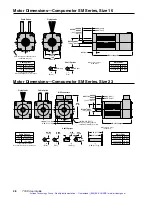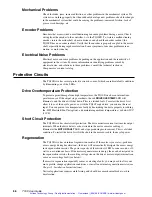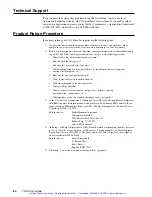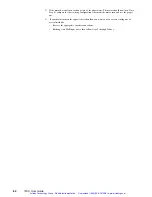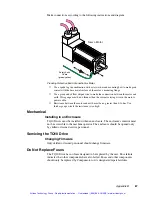
58
TQ10 User Guide
Oscillating currents, such as are seen when a system goes unstable during tuning, will
activate the foldback circuit if the current gets high enough, and the frequency of oscillation
is greater than about 20 Hz. Systems in this power range typically have resonant
frequencies much higher than this. The default settings suggested for each motor will result
in a latched fault after about 3.3 seconds above threshold. This time can be selected with
SW1-4,5,6. The sequence of events is: Current exceeds threshold, illuminating the
PEAK
CURRENT
LED (green). If this continues for longer than 3.3 seconds, the
IN FOLDBACK
LED will illuminate red, and current will be reduced.
If
SW2-1
is
ON
, then the
MOTOR FAULT
LED (red) will illuminate. The
IN FOLDBACK
LED may go out when the
MOTOR FAULT
LED turns on, depending on the load. Current
will be reduced to zero and the
FAULT OUT
will go active. This setting is recommended for
nearly all applications, since it causes a motor fault to be indicated. In most applications,
allowing the current to be reduced by foldback (without causing a fault) will result in the
controller faulting from excess position error, masking the source of the problem, or in the
production of defective product. The latched drive fault will lead the troubleshooter to the
source of the problem more directly. A mechanical jam, or increased friction in the
mechanical system are the common causes.
An exception to this would be an application where stopping the axis will lead to unaccept-
able consequences, and continued motion, even at a reduced rate, is preferable. An example
of this would be a conveyor drive running product through an oven which is hot enough to
melt the product eventually.
The default settings cause the timer to start when the current is approximately twice the
motor’s continuous rating (2 times Ics). The thermal switches in Parker servo motors will
protect a properly mounted motor in its specified ambient temperature, up to at least twice
Ics, at which point foldback takes over. If the peak current limit is set to three times Ics as
recommended, foldback will reduce current to a level below twice Ics, reducing the rate of
motor heating enough to give the thermal switch time to react, and protect the motor.
Note that foldback is not a substitute for proper sizing of the application, and does not
enforce a lengthy cooling-off period. As soon as the command goes below the actual
current, the circuit starts over. Applications with insufficient dwell time to allow the motor to
cool between periods of peak current will not be successful.
Foldback is intended to be a secondary safety net. Primary protection of the motor during
application problems should be provided by end-of-travel-limit switches, and by proper
setting of position-error faults in the controller. These will provide quicker, more direct
detection of end-stop or mechanical jamming problems in the application than foldback
can. If these systems fail, foldback can generate a fault (which stops all motor current) or
reduce the rate of motor heating to enable the thermal switch to operate.
Artisan Technology Group - Quality Instrumentation ... Guaranteed | (888) 88-SOURCE | www.artisantg.com





